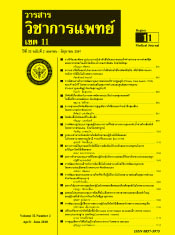Effect of the clinical practice guideline implementation for Ischemic stroke patients in Ranong hospital
Keywords:
clinical practice guideline, ischemic stroke patientsAbstract
The purpose of this retrospective study were to study the effects of the clinical practice guideline implementation for ischemic stroke patients. The research was conducted from October 2014 to September 2016. The sample group were 492 patients who were first diagnosed with ischemic stroke. Frequency, percentage, mean,standard deviation,paired-sample t-test were used for data analysis.
The results of the study found that In 2016,the clinical practice guideline approach for ischemic stroke patients 252 cases, of whom 15 cases were enrolled into the stroke fast track service. The patients in the stroke fast track service got thrombolytic agent rate of 0.79%. After the implement of the clinical practice guideline for ischemic stroke patients decreased readmission rate and died rate were significantly (p<.05), but did not decreased the complication rate. After the implementation, the expense of hospital stay had significantly less than before the implementation. The hospital stay had not significantly. It could be concluded that the clinical practice guideline implementation for ischemic stroke patients decreased readmission rate, died rate and the expense of hospital stay. So the concept should be used to care ischemic stroke patients for efficiency and quality of life
References
สถาบันประสาทวิทยา. แนวทางการรักษาโรคหลอดเลือดสมองตีบหรืออุดตันสำหรับแพทย์. พิมพ์ครั้งที่ 2 .กรุงเทพมหานคร:กรมการแพทย ์กระทรวงสาธารณสุข; 2555.
ศรัณยา โฆษิตมงคล, นิรมล สิรัฐพงศ์,วันเพ็ญ ภิญโญภาสกุล. การพยาบาลผู้ป่วยโรคหลอดเลือดสมองขาดเลือดเฉียบพลัน.ใน: เสาวนีย์ เนาวพานิช,วันเพ็ญ ภิญโญภาสกุล.บรรณาธิการ. การพยาบาลผู้ป่วยภาวะวิกฤตทางอายุรศาสตร์.พิมพ์ครั้งที่ 1.กรุงเทพมหานคร:ห้างหุ้นส่วนจำกัดภาพพิมพ์; 2558.
โรงพยาบาลระนอง. สถิติผู้ป่วยโรคหลอดเลือดสมอง ปีงบประมาณ 2555 - 2557.(เอกสารอัดสำเนา). ระนอง : โรงพยาบาลระนอง; 2558.
จิตลัดดา ประสานวงศ์,ปฐมวดี สิงห์ดง และรสสุคนธ์ สามแสน. การพัฒนาระบบการดแลผู้ป่วยโรคหลอดเลือดสมอง โรงพยาบาลศรีสะเกษ.วารสารกองการพยาบาล; 2555; 39 : 51-65.
Crawley WD. Case Management: Improving outcome of care for ischemic stroke patients. Medsur Nursing; 1996 ; 125 :1247-50.
เครือวัลย์ เปี่ยมบริบูรณ์ และ จรูญลักษณ์ ป้องเจริญ. การพัฒนารูปแบบการดูแลผู้ป่วยโรคหลอดเลือดสมอง โรงพยาบาลเจ้าพระยายมราช สุพรรณบุรี. วารสารพยาบาลกระทรวงสาธารณสุข; 2554 ; 21 : 4-21.
Kikemy MF.,Longworth M.,Pollack M.,Levi C.,&Cadihac DA. Factors associated with 28-day hospital readmission after stroke in Australia. Stroke; 2013 ; 44 :2260-2268.
Odderson IBR, McKenna BS. A model for management of patients with stroke during the acute phase outcome and economic implication. Stroke; 1993 ; 24
: 1823-1827.
อุมา จันทวิเศษ, พรชัย สถิรปัญญา, ฉมาภรณ์ วรกุล, ยุพิณ วัฒนสิทธิ์, ฉวีวรรณ ยี่สกุล และสิรินทร์ สาสตรานุรักษ์. ผลลัพธ์การใช้แผนการดูแลผู้ป่วยโรคหลอดเลือดสมองตีบและอุดตันในโรงพยาบาลสงขลานครินทร์.สงขลานครินทร์เวชสาร; 2552 ; 27 : 117-129..
Licthtman, J.H,Leifheit-Limson,E.C., Jones,S.B.,et al. Predictors of hospital readmission after stroke: A systematic review. Stroke; 2010 ; 41 : 2525-2533.
Sang Mi Kim, Sung Wan Hwang, Eun-Hwan Oh, Jung-Kyu Kang. Determinants of the length of stay in stroke patients. Osong Public Health Res Perspect;
2013 ; 4 : 329-341.






